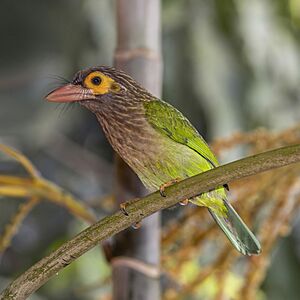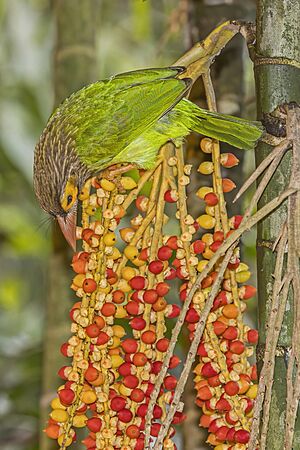Brown-headed barbet facts for kids
Quick facts for kids Brown-headed barbet |
|
|---|---|
 |
|
| P. z. zeylanicus, Sri Lanka | |
| Conservation status | |
| Scientific classification | |
| Genus: |
Psilopogon
|
| Species: |
zeylanicus
|
| Synonyms | |
|
Megalaima zeylanica |
|
The brown-headed barbet (Psilopogon zeylanicus) is a colorful bird found in parts of Asia. It's known for its bright green body and a unique brown head. These birds live in warm, wet forests and gardens across the Indian subcontinent, which includes countries like India, Nepal, and Sri Lanka.
Contents
About the Brown-headed Barbet
What's in a Name?
The brown-headed barbet got its official name, Bucco zeylanicus, way back in 1788. A German scientist named Johann Friedrich Gmelin gave it this name. He based his description on a bird from Sri Lanka. Today, this bird is part of a larger group of 32 barbets in the genus Psilopogon.
Different Kinds of Brown-headed Barbets
Just like people can have different looks depending on where they live, some animals have slightly different groups called subspecies. For the brown-headed barbet, there are three main types:
- P. z. inornatus: This type is found in western India.
- P. z. caniceps: This one lives from Nepal to central India.
- P. z. zeylanicus: You can find this type in southern India and Sri Lanka.
What Does It Look Like?
An adult brown-headed barbet has a streaky brown head, neck, and chest. It also has a bright yellow patch around its eyes. The rest of its body is a lovely green color.
This bird is about 27 centimeters (about 10.5 inches) long. It has a big head, a short neck, and a short tail.
What Does It Sound Like?
The brown-headed barbet makes a repeating call that sounds like kutroo…kutroo…kutroo. If one bird starts calling, others often join in. However, they tend to be quiet during the winter months.
Where Do They Live?
Brown-headed barbets are found in many places. Their home range stretches from the Terai region in southern Nepal all the way down to Sri Lanka. This covers most of peninsular India. Because they are so widespread, they are listed as "Least Concern" on the IUCN Red List. This means they are not currently in danger of disappearing.
How Do They Live?
Brown-headed barbets are arboreal birds, meaning they spend most of their time in trees. You can often spot them in gardens and wooded areas. They are quite comfortable around people and are often seen in city parks.
What Do They Eat?
These birds love to eat fruit and insects. They often look for food on fruit trees like mangoes, ripe jackfruit, papaya, bananas, and figs.
Nesting and Family Life
Brown-headed barbets make their nests inside holes in trees. They will often dig out the hole themselves. A female barbet usually lays 2 to 4 eggs. Both the male and female birds take turns sitting on the eggs to keep them warm. They often talk to each other using their Kura, kura calls while nesting.




